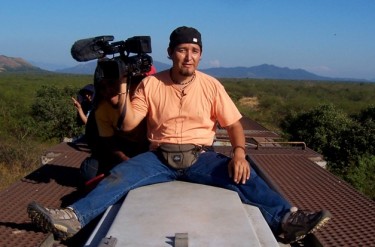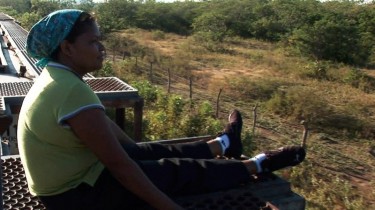There is arguably no single, obvious point of departure for a chronicle of the alarming and escalating violence against undocumented migrants in Mexico. But a survey of citizen media provides fragments that, taken together, constitute a grim series of intersecting narratives.
On August 1, 2011, the blog espacioperdido [es] published a post that began with a partial historiography of train travel in Mexico:
En 1999 cerro definitivamente la estación de ferrocarriles de Buenavista. Tiempo atrás se venían cerrando otras estaciones en distintas partes de la Republica. Con ello se cancelo definitivamente un logro de principios del siglo XX en Mexico: el transporte ferroviario de pasajeros. Actualmente solo quedan algunas rutas de carga…. Cargan mercancías, en forma de bienes y, desgraciadamente, de personas. Desde la frontera sur, en Ciudad Hidalgo, colindante con Guatemala, hasta las principales ciudades de la frontera norte, circula una de las mayores vergüenzas nacionales. La bestia o El tren de la muerte devore a miles de centro y sudamericanos. Viajan sobre los vagones, entre ellos y expuestos a todo, incluida la peor amenaza: el hombre.

Cargo train carries migrants traveling accross Mexico to cross the border into the United States. Image by Pedro Ultreras from his film The Beast, used with his permission
Writing for the grassroots journalism site barriozona [es], blogger Eduardo Barraza sheds further light on the aging freight trains that traverse this perilous route, and the passengers who may or may not arrive at their destinations.
In the United States many people refer to them derogatively as “illegals.” In the heart of Central America, these human beings represent some of the most disposed, desperate yet tenacious men and women leaving their impoverished countries in hopes to make it to the United States.
Unable to afford another form of transportation but also seeking to avoid Mexican immigration check points, thousands of Central American nationals from countries like El Salvador, Guatemala, Honduras or Nicaragua, dangerously and boldly hop on top of moving freight trains going from southern Mexico to many northern destinations along the U.S.-Mexican border.
Strikingly, both bloggers are writing with reference not only to the recent history of the region, but also to a specific cultural artifact shaped by those material events: a documentary film that takes its title from the sinister nickname given to the freight trains by the migrants who wager life and limb to board them.
Pedro Ultreras’ La Bestia (The Beast), first released in 2010, chronicles the filmmaker's journey atop the freight cars with the migrants, capturing for the cultural archive one perilous journey among countless others made every day by destitute and desperate migrants seeking paid work and a better life for themselves and their families. It affords visual testimony of events that continue to go unreported, or underreported, in mainstream media.
The director has posted trailers for the film on YouTube, both in Spanish, one with English subtitles.
The documentary has been screened this summer in cities and towns along the route of the ‘Paso a Paso hacia la Paz’ (‘Step by Step Towards Peace) caravan, involving hundreds of undocumented migrants and family members as well as human rights activists marching against the ongoing violations of migrants’ human rights, and demanding justice and legal protection for this vulnerable population.
Response to the film, as reflected on Twitter, has been positive and supportive. Georgina Cobos (@Ginacobos) signaled the upcoming screening of the film in the Mexican Senate:
Gran tarde con Pedro Ultreras que manana muestra #LaBestia al senado
A communications student at UNAM, Jessca Ramirez (@Jey_21), urged her followers to see the film:
Todos deberiamos verlo, estara hasta el miercoles en la Cineteca. El director lo realizo con SU dinero y deberiamos apoyar #LaBestia
Barbara Cabello (@Barbara_106) ventured her views both on the film and on the reality it documents:
#labestia en @cineteca nacional que buen documental, que triste que esto este en las entranas de Mexico y no se haga nada
In ‘Migrants as Targets of Security Policies,‘ blogger and Anthropology professor Christine Kovic refers to a group of migrants who were kidnapped on June 23 while attempting to reach the United States on a freight train:
What officials cannot deny is the extreme suffering and vulnerability of Central American migrants crossing Mexico. Without money to pay polleros (human smugglers) and to avoid checkpoints, thousands of migrants ride on the tops and sides of railcars where they are exposed to rain, extreme temperatures, dehydration, and electrocution. Many have lost limbs or their lives as a result of falling from the trains.
Traveling underground, migrants are vulnerable to assault, robbery, extortion, rape, and death.
Even with such powerful evidence of the plight of those willing to risk their lives along the dangerous “migrant trail,” a wider angle is perhaps required to situate the terrors of “La bestia” in a meaningful geo-political context. In the same post Kovic makes the case that enforcement operations intended to block the passage of migrants over the U.S.-Mexico border – no matter the toll in human suffering – have lately reached Mexico's southern frontier.
Deterrence policies have reached southern Mexico where migration officials have increased enforcement strategies, especially along the Isthmus de Tehuantepec, Mexico’s narrowest point. This is a security strategy encouraged by the United States to limit Central American migration. Most recently, the U.S.-backed Plan Mexico, also known as the Merida Initiative, provided significant funding to Mexico with the stated intention of “security aid to design and carry out counter-narcotics, counter-terrorism, and border security measures.” As former Assistant Secretary of State Thomas Shannon observed in 2008, “To a certain extent, we're armoring NAFTA.” What he does not say is that in doing so, poor and working class migrans, among other groups, are left unprotected by the “armor” and even become targets of security measures.
As recently as June of this year, Mexican Attorney General Marisela Morales identified the protection of Mexico's southern border as a national security issue, declaring that the “illegal flow of people and merchandise that exists and the delinquency it generates demand a strengthened institutional coordination to improve vigilance, security, and respect for human rights.” Kovic connects the dots:
If undocumented migrants passing through the region are part of the “illegal flow of people,” then rather than being the subjects of respect of human rights, they are viewed as generating delinquency. This framework partly explains the actions and inactions of the Mexican, U.S., and Central American governments that lead to the human rights abuses of migrants. These governments, along with transnational corporations, create the economic conditions that cause migration. Enforcement policies, including checkpoints on highways and along the U.S.-Mexico border, push people to travel in extremely dangerous conditions and create a market for human smuggling. Finally, impunity perpetuates abuses as those responsible are not prosecuted.









2 comments
Such a sad reality. Indeed these are the people who have both nothing and everything to lose in their quest for a better life for themselves and the families the continue to support once across the borders.